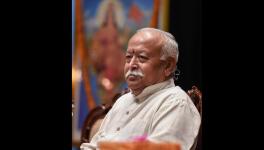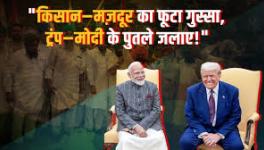The Remorseless Rise of the Modi Cult

Image credit: Hindustan Times
Some months ago, a visiting American journalist (unidentified, because the person has travelled several times over a considerable period of time on visitor visas due to the uncertainty of securing professional ones) made a startling assertion.
Before 2014, he said, one could spend several weeks in India and return without ‘being made aware’ of the identity of the Indian Prime Minister. The publicity machinery was imperceptible although political hoardings were not so scarce.
“It is no longer the case, the moment you step out of the aircraft and enter the terminal at any airport, you will see (Narendra) Modi’s pictures; you know immediately that he is the most important leader here,” he said. “You go anywhere within the country, the situation is the same,” he continued. Indeed, Modi is the universal mascot, the one who has personally ‘spearheaded’ everything good that’s ever happened.
No one will disagree with this observation. Giant hoardings in which the most dominating image is Modi’s, the others are reduced to alter-egos or incidentals, stare down at every passer-by.
Modi and numerous avatars of his – the sagely guru of the pandemic days to the forester of visits to jungles, do not just ‘physically dominate’ India’s public and media space.
Instead, due to the ever-growing presence of social media, the vice-like grip over mainstream media content, and because the government and the Bharatiya Janata Party have possibly the biggest publicity apparatus globally, no one can surf the internet without confronting one of Modi’s visages.
Since 2014, Indians have seen the remorseless rise of the personality cult. Modi now is like kings from the past around who everyone else circumambulated.
His trait is copy-pasted by nearly all Bharatiya Janata Party chief ministers and even several opposition ones and they become Chhota Modis in their circle of influence.
But, the Centre poses questions and demands payment of the amount spent on publicity, only from non-BJP chief ministers.
Modi’s (now one-time) ideological vanguard, the Rashtriya Swayamsevak Sangh, a believer in the primacy of sangathan or organisation over the individual and eschewer of vyakti puja or deification of a person, has looked askance at individualisation of the polity.
The BJP started the groundwork for next year’s parliamentary elections since the beginning of this year. Besides drawing up numerous political strategies, in recent weeks it released three separate video films which bolster the Modi cult and projects him as being instrumental for all government programmes and initiatives – the only caregiver and usherer of progress, development and growth.
This adds to the much trumpeting of 100 episodes of Mann Ki Baat later this month, which too is billed as a commanding achievement. Each of these, not just aims to put Modi on a pedestal, but also claims that he is the only one who can resurrect India’s ‘past glory’.
The films claim that Modi has notched innumerable accomplishments despite all-out efforts of adversaries to derail his engine.
The first of these videos, Mujhe Chalte Jana Hai, a party production, was released in mid-March and is 4.30 minutes in duration. Besides being distributed through the BJP’s narrative-influencing WhatsApp network and party websites, it is available on multiple websites of several mainstream media organisations.
The other two videos were telecast on Doordarshan but were commissioned to an outside agency. The two episodes are anchored by Kamiya Jani, the food and traveller vlogger who was in news in recent months for interviewing Rahul Gandhi while on his Bharat Jodo Yatra. These two 30-minute documentary films were telecast on April 15-16.
All three films are thinly disguised cinematic productions aimed at furthering Modi’s image as the only leader respecting India’s traditions and values and makes effort towards modernising these.
India’s heritage that is showcased in the documentaries is exclusionary because barring an odd shot of a Sikh gurudwara, no visuals underscore India’s pluralism from its earliest days. Routinely, mythology is passed as history and fables are presented as actual events.
The first film is a play on the famous Kishore Kumar/R.D.Burman song from the hit 1972 film, Parichay, Mujhe Chalte Jaana Hai, Bas Chalte Jaana Hai (I have to soldier on, just soldier on).
The idea is clear: evoke lyrics of the evergreen song in viewers’ minds and lead them into perceiving Modi as the ‘real-life’ Jeetendra (the actor on who the song is situated in the film) who sings along: “Musafir hoon yaaron, na ghar hai, na thikaana...” (I am merely a traveller, no home, no permanent address...)
The title cunningly buoys the decade-old mythology of Modi’s selflessness and material nothingness.
The animation film is made like comic ‘shorts’, produced ad nauseam on current events by news channels. The difference being that the message is downright portentous, albeit communicated subtly. The animation portrays Modi climbing the stairs without a break, save when he stops to ‘listen and help’ the needy – small traders, to who he disburses loan, and farmers for who he rolls out a slew of welfare schemes with ‘his own hand’.
Modi is not just annadaata (provider of food) but also the one who builds houses, and toilets, provides taps with water in them. In short, he is an all-in-all provider who goes about his job despite obstacles that the opposition raises. Because this falsity is repeated continually, the contestations too must be restated.
His journey is shown starting from Modi overcoming Sonia Gandhi’s inopportunely used barb, Maut Ka Saudagar (Merchant of Death) in 2007.
Importantly, Modi’s political journey to the prime ministerial chair is not shown to be flagged off with the 2002 Gujarat riots that are conveniently glossed over; although this grisly episode is what enabled Modi to lay out a launch pad.
In all the films, a deceptive strategy is continually repeated – selective events are picked and adequately pickled while others, especially the politically ‘awkward’ ones, find no mention, as if, it never occurred.
The chronology of the 4.30-minute video, on expected lines, straddles Modi’s accession to power and the tightening of his strangulating clasp over significant sections of Indians.
Mani Shankar’s Aiyer’s January 2014 ‘chaiwallah’ dig which backfired, Digvijay Singh likening Modi to Ravan from the Ramayan and Rahul Gandhi’s allegation on the Rafale deal and his slogan, Chowkidar Chor Hai (Sentry is also the thief) are presented as affronts to India’s progress under Modi’s watch.
Modi’s ‘power’ is so great that a Rafale plane meekly lands at Modi’s feet. This is nothing but presumptuousness.
The intention is clear, every ‘good’ scheme, from Swachh Bharat Abhiyan to the recent inaugural of the HAL Helicopter factory in poll-bound Karnataka, proves Modi’s incessant drive and divine vision. (In response to a question I once asked while researching his biography, he said that he at times felt that he “had God’s gift”.)
The rule of publicity films is to keep out unpleasant memories. Consequently, there is no mention of harrowing experiences, short-sighted demonetisation, criminal mismanagement during the vicious second wave of the pandemic in 2021, or others.
The pandemic is shockingly portrayed as a moment of personal glory and Modi is shown as personally carrying the vaccine over a treacherous valley teeming with viruses lying in wait.
The documentaries are more politically devious. Part I of Dharohar Bharat Ki – Punuruthan ki Kahaani opens with multiple Hindu religious symbols presented as vignettes of ‘Indian culture’ and its aatma (soul). Unstated tales of valour are narrated with the images of VD Savarkar providing the backdrop.
The visuals string together images from Somnath to Kedarnath to peddle the proof of India’s resurrection, from Dholavira to Purana Qila, to establish a direct connection between ancient India and the present with no mention of the medieval period.
The film shows predictable scenes from Andaman and Nicobar Islands to Delhi to pay respect to ‘ignored’ national heroes.
The two aforementioned Hindu temple sites are chosen because the two-faced destruction – Somnath in history from ‘barbaric invaders’ and Kedarnath due to nature’s wrath in 2013.
Both were ‘restored’, it is claimed, under Modi’s watch. Modernisation of the Somnath complex is claimed to have been completed in August 2021 with the construction of a promenade and the launch of several other projects. Likewise, the rebuilt shrine at Kedarnath was inaugurated, again by Modi, three months later in November 2021.
The anxiety to provide Modi’s signature on the ‘jazzed-up’ Somnath complex results in the standard Hindutva narrative of the temple being destroyed multiple times by Muslim invaders. The documentary makes no mention of the roles of Sardar Patel and Rajendra Prasad in the temple reconstruction at the dawn of the Indian Republic.
The narrative on the path from Andaman Islands to Delhi starts and ends with the two compulsive choices of the BJP: Savarkar’s image at Cellular Jail and Subhash Chandra Bose’s new statue at the other end of ‘Kartavya Path’.
The documentary speaks of Modi’s pluck to install Netaji’s statue beneath the canopy intended for a British Monarch, which was vacant for so long because of ‘indecision.’
The deliberate ‘erasure’ of the contribution of several nationalists is a recurring chant, but no reference is made to those whose memories and names were kept alive previously. Their time is clearly over!
Part II of the documentary comprises visits to religious sites restored or renovated since 2014. Somnath, Mahakal in Ujjain, and Shaktipeeth in Pavagarh, Gujarat are spoken about to flag off the segment. The voice-over mentions that a flag fluttered atop the hill shrine but this ceased after Sultan Mehmood attacked the temple.
The documentary shows footage of Modi hoisting the flag, reinforcing his image as Hindu Hriday Samrat.
The story thereafter shifts to Varanasi and eventually to Ayodhya. On both occasions, the emphasis is singular – ‘barbaric’ Muslim rulers destroyed ancient revered Hindu temples and remained in pitiable or poor state, till Modi took it upon himself to resurrect these sites.
These films have one central message: Modi is the messiah of a ‘new’ India that is aware of its past and takes pride in it.
This is possible, claims the films, because Modi is at its helm. Early in the second part, after visually establishing temples that require attention, the narrator raises questions: Is there anyone who can be given this responsibility? Is there anyone who is willing to take this responsibility?
Can there be a better prompt than this?
Congress leader Dev Kant Barooah once infamously stated during Emergency, “Indira is India, India is Indira,” to underscore epic levels of sycophancy.
The three films are an integral part of the effort to build a new Modi mythology.
Modi is presented as India’s past, present and future. He is in fact, the continuum.
Undoubtedly, this message will form the core of the platform on which the BJP shall mount its campaign to secure a third term in office in 2024. Truth and inclusiveness be damned.
Frank Dikötter, the author of the much-acclaimed book, Dictators: The Cult of Personality in the Twentieth Century, wrote in the book: “Dictators who survived often relied on two instruments of power: the cult and terror.”
We have witnessed events in recent days that deepen the latter. These films, and the narratives they shall spawn, will further tighten the stranglehold.
The writer is an NCR-based author and journalist. His latest book is 'The Demolition and the Verdict: Ayodhya and the Project to Reconfigure India'. His other books include 'The RSS: Icons of the Indian Right' and 'Narendra Modi: The Man, The Times'. He tweets at @NilanjanUdwin.
Get the latest reports & analysis with people's perspective on Protests, movements & deep analytical videos, discussions of the current affairs in your Telegram app. Subscribe to NewsClick's Telegram channel & get Real-Time updates on stories, as they get published on our website.
























